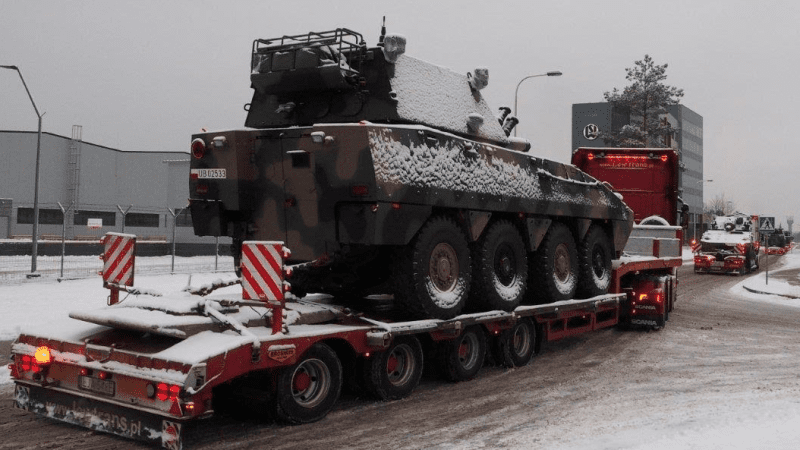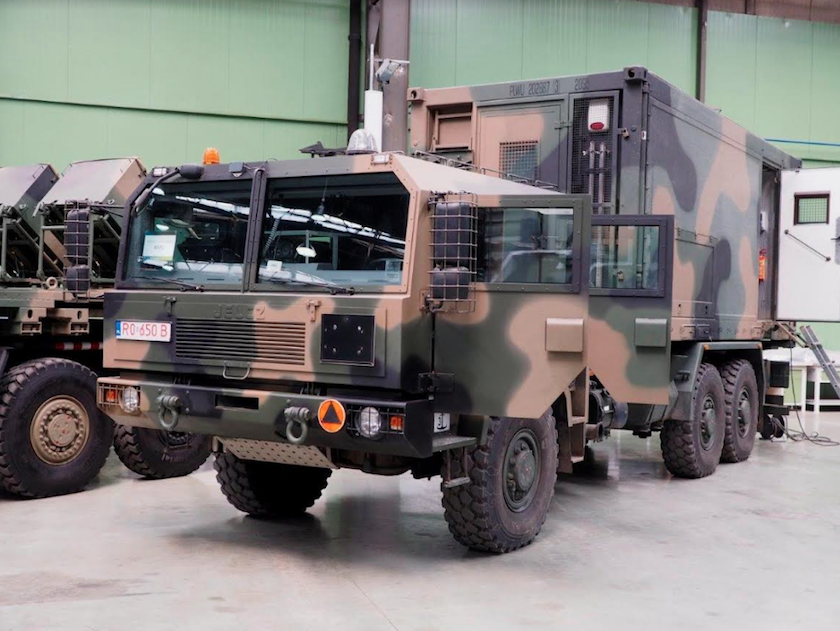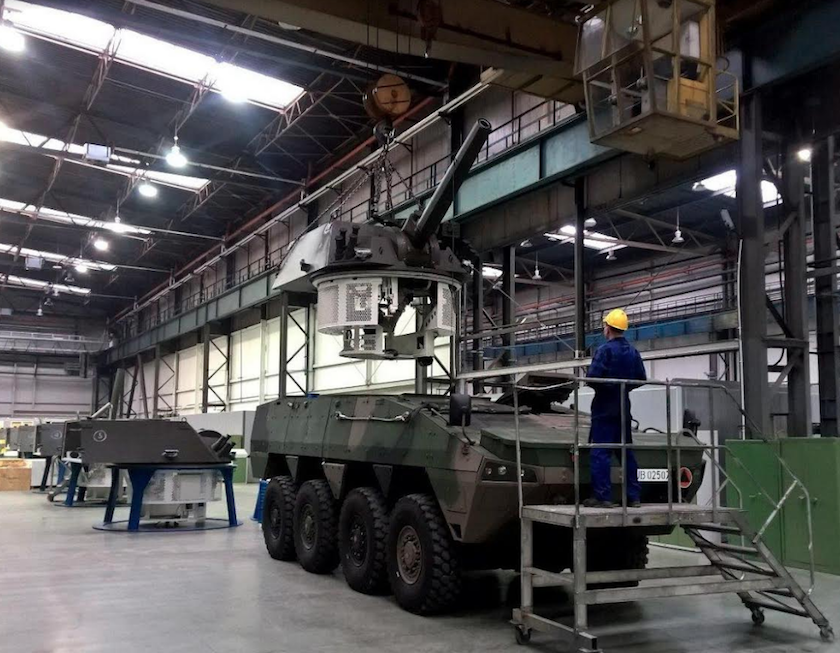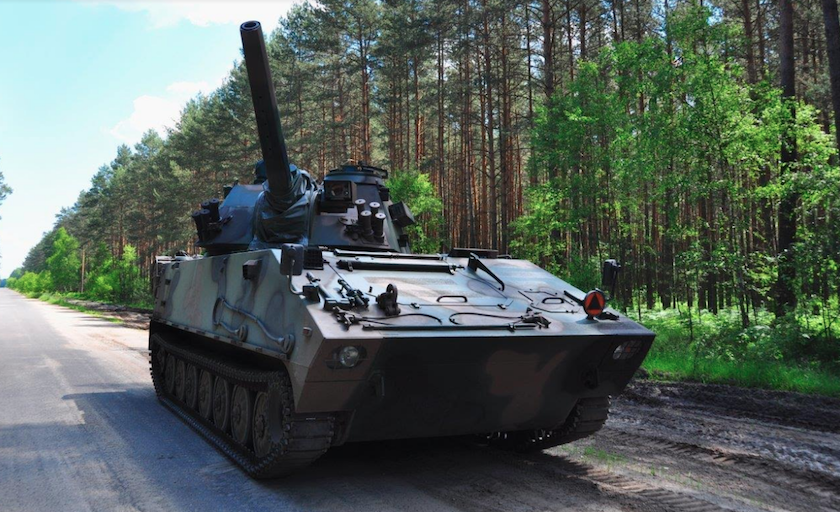Rak Mortars Headed to Giżycko

A convoy including the equipment for the next KMO unit (Company-level Fire Module), with the 120 mm Rak self-propelled mortars, has left the HSW S.A. facility on Monday morning. The equipment is to be received by the 15th Mechanized Brigade stationed in Giżycko, 500 kilometres away. Formally, the vehicles would be handed-off for use within the 15th Brigade at the end of January. The whole procedure is expected to be accompanied by a field demonstration showcasing the mortars and the level of training and skills attained by the crews.
In this way HSW S.A. would complete the next phase of the agreement signed on 28th April 2016. The contract in question assumes that equipment shall be delivered to eight KMO Rak units. Each and every module consists of 8 fire units (M120K mortars based on Rosomak APC), along with 4 AWD command vehicles (one for each of the fire platoon commanders, and for the company commander, as well as a reserve vehicle for the deputy company commander). Training services are also a part of the aforesaid contract, with a gross value of PLN 968.3 million.
Starting from late autumn last year, the artillery component of the 15th Mechanized Brigade was involved in a theoretical training programme at the HSW facility. During the said training, the soldiers got acquainted with the design and principles of operation pertaining to the new equipment. They also were involved in practical exercises. The whole procedure is identical to the one adopted last year, for the first users of the Rak system. The first KMO unit has been incorporated in the structure of the 17th “Digital” Mechanized Brigade (based in Międzyrzecz) back in June, while the second one became a part of the 12th “Blue” Mechanized Brigade (based in Stettin) in October. Both elements utilize Rosomak APCs with Hitfist 30P turret modules.
“This is yet another important day for us, as a manufacturer. According to the Agreement signed in April 2016, we are handing off the third company-level fire unit for further use by the Polish Military, without any delays. We are working on this contract which is very important for us, also being one of the most significant contracts signed within the Polish defence industry. The contract in question is defining a path of positive changes that would happen at our company”
15th Mechanized Brigade based in Giżycko is the second unit stationed in the area close to the Kaliningrad Oblast and the Suwałki Gap, which is receiving a modern artillery system delivered by HSW. In August last year the 11th “Mazurski” Artillery Regiment based in Węgorzewo received the Regina 155 mm self-propelled artillery system. The unit in question became the first user of the Regina Squadron Level Fire Module (DMO) in the Polish military. The “module” includes, along the 24 Krab self-propelled howitzers, 18 support platforms: 8 command vehicles (WD) and 3 command and staff vehicles (WDSz), 6 ammunition carriers (WA) and 1 mobile armament and electronics repairs workshop (WRUE).
Ultimately, a similar structure would also be adopted in case of the support companies operating the 120 mm self propelled mortars. Nonetheless, as the test procedures concerning the remaining elements of the KMO units are delayed, it was decided that components that are ready for the series production would be acquired. The above applies to the mortar and to the AWA artillery command vehicle platform. The remaining vehicles would be procured through separate tendering procedures. In this way, on 28th December 2017, the delivery of 8 AWRU (vehicles tasked with repairs of the electronic components and armament) platforms was finalized. One vehicle is going to be received per one module.

Once the Artillery Ammunition Vehicle (AWA - Artyleryjski Wóz Amunicyjny) passes the qualification tests programme, it is planned that a relevant procurement contract is concluded too. Structurally speaking, each of the KMO units is to use 3 AWA platforms. AWR (Artyleryjski Wóz Rozpoznania - Artillery Reconnaissance Vehicle) platform is the last of the components of the KMO units to be acquired by the Polish Ministry of Defence. However, as a decision was made to base the said element on the Rosomak APC (instead of the AMZ Żubr vehicle), the contract within that regard would be delayed – time is needed to develop a new variant and carry out the qualification test programme. Each of the support modules would use two AWR platforms.
HSW is obliged to deliver another two Rak modules by the end of this year. Another three systems expected to be received next year would conclude the finalization of the April 2016 contract. At the moment, there’s no clarity as to whether the Polish Ministry of Defence would be interested in expanding the structures of the existing modules, once the order is finalized. For instance, the Ministry could add a single platoon to each of the units or increase the number of support companies equipped with the M120K mortars. Alternatively, the MoD could start ordering the tracked M120G variant of the system. M120G platform is expected to become a support means in heavy brigades.
LPG chassis is the platform expected to be used with the M120G version. Design-wise it is similar to the vehicles used in case of the WD and WDSz systems of the Regina solution. After 2021 HSW will also have a new generation IFV platform at its disposal, following the scheduled finalization of the research and development initiative related to the Borsuk vehicle. This would be followed by achieving readiness to series manufacture the IFV. Undoubtedly, in case of the support vehicles that are to be embedded in the artillery units, no amphibious capabilities are required. A whole family of vehicles utilizing the Borsuk platform is expected to be created, including MEDEVAC, reconnaissance, ABC reconnaissance or engineering vehicles.

HSW S.A. is pursuing its series production initiatives in tough conditions, with many changes emerging externally at the MoD and in the military, as well as with numerous amendments made to the Polish military’s Technical Modernization Plan (2013-2022). In some areas the changes translate into cancelled priorities. HSW S.A. is, primarily, forced to reorganize its structure, as the company transitioned rapidly from R&D stages into series production of Rak and Regina systems. Meanwhile, the company still continues its R&D work in the areas of Homar, Wisła, Borsuk and Kryl programmes. All of the above is taking place with simultaneous implementation of complex, costly and multi-staged investment and modernization initiatives.
The first one concerned the expansion and modernization of the barrel production facility, which came with a pricetag of PLN 35 million. At the moment, the whole complex allows the HSW S.A. company to manufacture barrels within a calibre range between 30 and 155 mm. This also concerns long barrels, with lengths of more than 8 metres. The second programme is aimed at creating a new process facility which would be tasked with manufacturing large dimensional hulls for armoured vehicles. This mainly concerns turrets and platforms for Krab sphs and hulls for the Borsuk IFV. The company obtained extra financing from the Ministry of Development to support this investment, amounting up to PLN 7.7 million. The money has been used to acquire new welding technologies.
Construction works concerning a new production hall, with an area of 3.5 thousand square metres, also show a surprisingly good progress - thanks to the fact that the winter season has been mild so far. The advancements made are greater than it was assumed. During the last quarter of the year the whole facility is to gain production readiness. It is going to be equipped with robotized welding lines and RTG weld control chamber. All of the assets above will be complemented with a multifunctional machining system for mechanical machining of the vehicle bodies. Up until now, the company should also have all process documentation and production hardware at its disposal, required to initiate the series manufacturing of the K9PL platform, known as PK9 at HSW (polonized K9 sph). Furthermore, the entity should also have concluded agreements with the cooperating parties.
Since the last quarter of last year the company has been working on translating and converting the technical documentation, so that it is compliant with the Polish norms. The documentation has been transferred, on the basis of an agreement signed in December 2014, by the Korean partner - Hanwha Techwin, now known as Hanwha Land Systems. The licensing company would be required to support HSW, until the Polish facility reaches full capability to manufacture the platforms. The first of the series-manufactured Regina modules would be using, partially, Korean platforms, assembled at HSW with the use of kits delivered by Hanwha. Some of the new systems, however, would be, in their entirety, assembled at HSW.
The supplies concerning the Krab systems, as well as the remaining elements (in total: 8 SPHs, 4 command platforms, 2 ammunition carriers and 1 repair vehicle) for the first battery of the series manufactured Regina module, already delivered to the 11th Artillery Regiment within the framework of the “Deal of the Century), are scheduled to end in October 2018. Krab systems using the chassis made in Poland will be delivered to the military starting from 2019.
Series manufacturing of the M120K system does not mean that the system development is finalized. Decisions have been made to implement design modifications as the production lasts, in the feeding mechanism and base sections of the Rak mortar. Furthermore, it was assumed that the barrel manufacturing process would utilize the autofrettage technology. The procedure reinforces the barrel internally. The process is pressure-based, with the pressures reaching the level of 7 to 8 thousand bar. It crushes the steel’s crystalline structure, which results in increased hardness and resistance to mechanical damage and wear. Not only does the operation above extend the barrel lifetime, but it also limits its wear, which makes it possible to attain consistent performance, accuracy and range.

The implementation of autofrettage is a part of the modernization procedure concerning the barrel manufacturing facility. The technology is going to be employed primarily in case of the 155 mm howitzer barrels, with their lengths exceeding 8 metres (Krab and Kryl). Dynamic Test Centre of the Military Institute of Armament Technology in Stalowa Wola created a test station for the Rak mortar at the HSW facility, and back then it was decided that autofrettage would be employed, within the process of manufacturing the barrel for this station. The whole station is going to be used to test ammunition, for instance, with larger powder charges. This did not pose a great technological challenge, since the aforesaid barrel is only 3 metres long.
The success achieved led to a decision to implement this process in case of series manufactured Rak units. Joint arrangements have been made by and between the MoD and HSW, even though the former entity did not expect the technology to be employed initially. The changes in question facilitating the use of new type of HE rounds would be implemented in case of fifth and further company module elements.

Similarly as in case of Rak modules, with their three components (AWRUE - now, AWA - soon, AWR - later) catching up, when it comes to deliveries, with the M120K and command platforms, ammunition development process is also showing good progress.
Until ZM Dezamet finalizes the work on the ammunition designed for Rak, the units would utilize the old OF843B rounds for towed mortars. Despite the fact that maximum performance of the mortar cannot be obtained with that ammunition (as the shell is not rigid enough, one cannot use the strongest propelling charge which would generate pressure of up to 250 MPa in the barrel), the MoD accepts the situation.
Firstly, the old ammunition may be used in crew training and tactical training applications, integrating the support company elements. Secondly, this also partially solves the problem of disposing of the old ammunition stored by the military. For instance the artillerymen of the 17th Mechanized Brigade have used up around 300 OF843B mortar rounds during an exercise organized in Nowa Dęba in August 2017. Międzyrzecz-based units training in Wędrzyn also intensively use the very same ammunition with the Rak mortar. Soon, Giżycko based 15th Mechanized Brigade would also make use of the said rounds.
Jerzy Reszczyński
